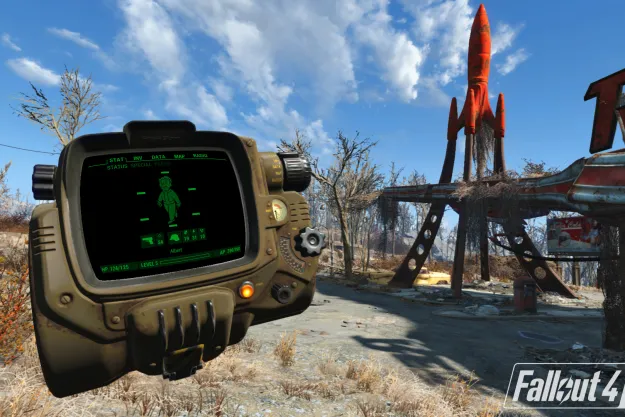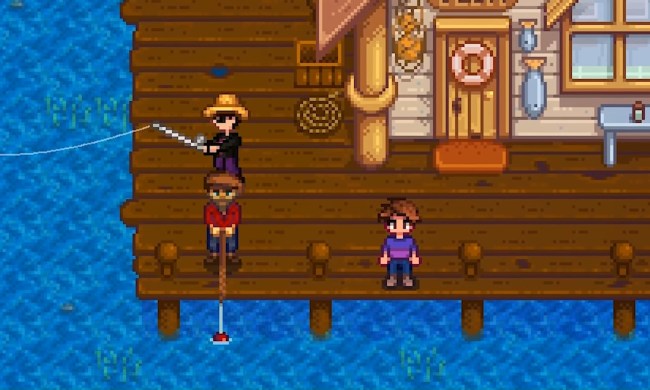
“Exploring the wasteland in ‘Fallout 4 VR’ feels incredible, but the gameplay suffers in the transition to virtual reality.”
- It’s Fallout 4 in VR
- Amazing sense of scale
- Aiming guns feels more precise in VR
- Clunky, complicated menus
- Movement options may make it difficult to play for long
Taking a traditional game and molding it to fit within VR is a tenuous, high-risk proposition. Making a mistake or a sub-par port on a standard game system isn’t a huge deal: It’ll still sell, some folks will be ticked off by bugs, and others will just be happy that they get to step into a new game world they’ve missed out on. But a poorly-made VR game stands out, in part, because of the intimacy the medium allows. By stripping away the layers that separate player and game, any missteps become that much more jarring — and potentially nauseating.
Fallout 4 VR is a testament to both the challenges of adapting traditional games into VR, as well as the potential payoff. The third in a trio of VR games and adaptations from publisher Bethesda based on its core franchises, Fallout 4 VR is incredibly ambitious, offering players a much deeper experience than what we’re used to. VR games, at least for now, tend to work best in smaller areas that can be totally explored and poked and probed. The post-apocalyptic setting of the Fallout series is anything but. Exploration abounds, yes, but these are large, expansive worlds that take many, many hours to explore.
Somehow, though, Fallout 4 makes the transition effortlessly. Wandering around the bombed-out, retro-future gas station, or cobbling together your own post-apocalyptic settlement with found objects is a wonder. At times, Fallout 4 VR is an impeccable amusement park, but, as we lay out in our review, it is still not the ideal way to play Fallout 4.
Touring the end of the world in VR
Much like its predecessor, Fallout 4 opens with you, your spouse, and your infant son taking shelter during the nuclear apocalypse. Your trio is placed into suspended animation, after which your child is kidnapped, spouse killed, and you wake up some unknown time later hunting for the blood of the villains that did it. In-game, this means that you’ll traipse about the ruins of Boston, some 300 years after the bombs fell.
While a bit tonally dissonant, your adventure isn’t so much driven by the plot as it is your own, personal curiosity about the world in which you find yourself. The pace approximates the steady exploration of the original, non-VR Fallout 4, while still getting some big wows by allowing you to physically poke around this world.
Poring through the cluttered wastes of New England’s ruins like an archaeologist, the game allows you to indulge your curiosity by taking a very close look at every little detail. Fallout 4 VR, above all else, wants to make you feel like you’re in this world. It sounds so basic, but the ability to simply inhabit such a distinctive place feels wondrous.
Cobbling objects to build your very own post-apocalyptic settlement is a joy
Fallout 4 VR’s biggest victory may be that it’s playable for long stretches at all. VR can wear on the body. Especially for those that aren’t used to it, and that’s well before we get to any of the issues of comfort. Physically wearing the headset for hours on-end, for instance, just isn’t anything like lounging on a couch or even sweat on the areas covered by a head-mounted display. Fallout 4, rolls with that, though, and keeps things nice and light.
Like many VR games, players move primarily via point-and-click teleportation: You mark a spot in visual range, then press a button on the Vive remote to instantly warp to it. Unlike the much more active DOOM VFR, which also relies on that kind of movement, Fallout 4 VR allows you to move comfortably at your own pace.
The game’s combat feels subdued, thanks to the bullet time-y effect of the series’ aiming mechanic, V.A.T.S., which slows down time, highlights vulnerable body parts, and generally allows you to aim and shoot at enemies without any real pressure.
Stranger in a strange land
While VR enhances the immersive narrative elements of Fallout 4, the more mechanical gameplay is definitely not as fun. Battling beasts in the wastes feels natural, but comes off as a distraction. Where once the FPS and RPG were balanced in the original, its VR counterpart is totally distinct, at least in the type of experience it offers.
Much of the game, in fact, suffers immeasurably from the transition to VR. Menus, drawn into the air seemingly out of magic from the in-game PDA-like wrist-mounted Pip-Boy, are visually stunning, but clumsy to use. You must bring your wrist up to face you every time you want to access even basic options. That wasn’t particularly great even with a smartphone app designed for the purpose in the real world, but here it’s straight-up tedious.
Similarly, talking to people, a core component of this (and any) role-playing game, is far more alienating. Your avatar speaks with a voice that isn’t your own. They don’t have hands, even. Interacting with the world almost always dispels the magic around simply wandering around.
Most characters’ motivations — especially your own — don’t quite mesh with the world of Fallout 4
Even worse, glaring weaknesses in Fallout 4’s quest design and writing are made that much more obvious by their virtual juxtaposition. Often characters speak of things they can’t possibly have knowledge of.
Characters react in unreal and inhuman ways, and don’t seem to realize that RPGs are so loved because of the breadth of options players have to approach problems. In Fallout 4 VR, most of that gets cut done to only the most rudimentary means of interaction. You cannot, for instance ask where people or from, or why they behave the way they do. Most characters’ motivations — especially your own — don’t quite mesh with the world that Fallout 4 is trying to build. And practically being there makes all of these mistakes more frustrating.
Inhabiting another being, scouring dilapidated homes and long-vacated streets of Boston feels much more hollow in VR. When your relative inability to affect change or simply carry a conversation with its people is so obvious, it’s much harder to settle in. These missteps can be overlooked in a game, when your TV and controller (or keyboard) offer extra layers of abstraction, but the game’s limitations feel far more glaring when you’re there.
Fallout 4 VR offers something special, especially for players who are already Fallout fans. Touring the run-down Nuka Cola amusement park or the coasts of the North Atlantic in this irradiated hellscape never quite loses its charm. Though, frankly, the fact that it works at all, which is far more than you can say for many similar VR titles, is technically impressive.
Ultimately, Fallout 4 VR trips over itself quite a bit. If you can drop all pretense of inhabiting a world, of being a part of it, then you’ll have no issues. Just know that you’ll be more of a fly on the wall than a citizen.




